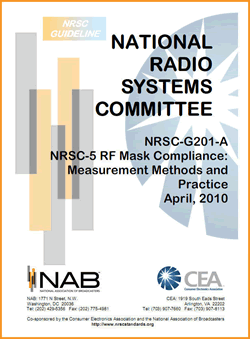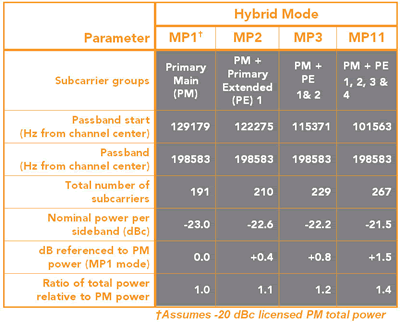|
NRSC Updates G201 RF Mask Compliance Measurement Guideline
 One
of the ongoing missions of the National Radio Systems Committee
(NRSC, www.nrscstandards.org)
is to develop recommended practices for the radio broadcasting
industry, called �NRSC Guidelines,� that help broadcast engineers
and receiver manufacturers work together to offer the best possible
terrestrial radio service that they can. At the most recent meeting
of the NRSC�s DRB Subcommittee, held last Saturday in Las Vegas
in conjunction with the 2010 NAB Show (April 10-15, 2010, www.nabshow.com),
an update to one of these Guidelines was adopted that adds information
on a new digital radio quality metric which promises to help broadcasters
identify and correct potential problems in their transmission
plant. One
of the ongoing missions of the National Radio Systems Committee
(NRSC, www.nrscstandards.org)
is to develop recommended practices for the radio broadcasting
industry, called �NRSC Guidelines,� that help broadcast engineers
and receiver manufacturers work together to offer the best possible
terrestrial radio service that they can. At the most recent meeting
of the NRSC�s DRB Subcommittee, held last Saturday in Las Vegas
in conjunction with the 2010 NAB Show (April 10-15, 2010, www.nabshow.com),
an update to one of these Guidelines was adopted that adds information
on a new digital radio quality metric which promises to help broadcasters
identify and correct potential problems in their transmission
plant.
NRSC-G201-A,
NRSC-5 RF Mask Compliance: Measurement Methods and Practice, was
developed by the Subcommittee's IBOC Standards Development Working
Group (ISDWG) which is chaired by Dom Bordonaro, chief engineer,
Cox Broadcasting - Connecticut. Geoff Mendenhall, VP transmission
research and technology at Harris, and Harris' representative
to the NRSC, led the ISDWG sub-group responsible for the updated
portions of the Guideline, which describe a new, standardized
method for determining the transmission quality of an FM IBOC
signal called Modulation Error Ratio (MER). At Saturday�s meeting,
Bordonaro indicated that with the FM IBOC MER technique now developed,
the ISDWG is planning to now consider development of a similar
capability for AM IBOC.
Broadcasters
can use MER to assess the performance of their transmission facility
and to potentially identify problems resulting in a less-than-optimum
signal. This Guideline update is based upon measurement techniques
described in a new "reference document" from iBiquity Digital
Corporation entitled Transmission Signal Quality Metrics for FM
IBOC Signals. This updated Guideline will help the industry better
understand MER as transmission and signal measurement equipment
manufacturers are expected to soon offer the industry new and
improved devices incorporating MER techniques (see the September
28, 2009 issue of Radio TechCheck for additional information
on the iBiquity reference document).
MER is a
type of �digital signal quality� testing as opposed to other types
of signal quality testing such as measurement of spurious RF energy
or harmonic distortion. Digital signal quality testing involves
the analysis of digital waveforms (in the case of IBOC MER measurement,
symbols of the baseband signal) for their deviation from the corresponding
ideal waveform . This is a powerful technique to characterize
the overall �health� of a transmitted signal and help troubleshoot
problems with transmitted IBOC signals. Distortions of the waveform
increase the chance of receiving errors in the symbols used to
represent the digital information. These distortions can be measured
and the results can be compared to recommended specifications.
In addition
to the information about MER (which is contained in Section 4.4.3
of the document), the Guideline has also been updated to include
new information about the relationship between the total digital
signal power in an FM IBOC signal relative to the digital signal
power in the �Primary Main� subcarrier group. In the table shown
below (taken from Table 2, Annex 1 of the Guideline), the last
row has been added to provide information on the additional amount
of digital power due to the addition of the so-called �Primary
Extended� subcarrier groups which broadcasters may use to increase
the data capacity of their signal. This is valuable information
because it can help broadcast engineers understand the amount
of additional digital power they are allowed to transmit relative
to their authorized power as they elect to implement Extended
hybrid modes of operation (which use the primary extended subcarriers).
 The
NRSC-G201-A document will be available free-of-charge on the NRSC�s
web site at www.nrscstandards.org,
following a final, procedural review which will take approximately
two weeks. The NRSC is a technical standards-setting body co-sponsored
by the National Association of Broadcasters (NAB) and the Consumer
Electronics Association (CEA). Additional information about the
NRSC, including information on becoming a member, is also available
on the web site. The
NRSC-G201-A document will be available free-of-charge on the NRSC�s
web site at www.nrscstandards.org,
following a final, procedural review which will take approximately
two weeks. The NRSC is a technical standards-setting body co-sponsored
by the National Association of Broadcasters (NAB) and the Consumer
Electronics Association (CEA). Additional information about the
NRSC, including information on becoming a member, is also available
on the web site.
Additional
details and registration information for the 64th NAB Broadcast
Engineering Conference is available at www.nabshow.com.
For 2010, the NAB Show is proud to offer smarter registration
packages that give you access to more � more sessions, more cross-conference
access, more year-round learning opportunities, more networking
� all for one great price. Check out the Best
Value Packages including a new SMART Pass and Conference Flex
Pass.
ADVERTISEMENT

|
ADVERTISEMENT

|
The
April 12, 2010 Radio TechCheck is also available
in an Adobe Acrobat file.
Please click
here to read the Adobe Acrobat version of TV TechCheck
|

